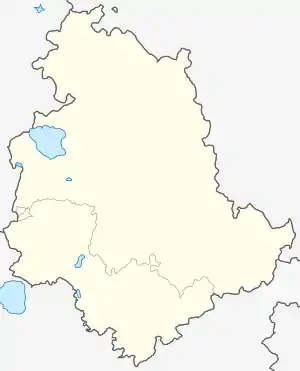Sellano | |
|---|---|
| Comune di Sellano | |
 | |
 Coat of arms | |
Location of Sellano | |
 Sellano Location of Sellano in Italy  Sellano Sellano (Umbria) | |
| Coordinates: 42°53′N 12°56′E / 42.883°N 12.933°E | |
| Country | Italy |
| Region | Umbria |
| Province | Perugia (PG) |
| Frazioni | Apagni, Cammoro, Casale, Celle, Ceseggi, Civitella, Colle, Fonni, Località Torre di Cammoro, Mocali, Molini di Cammoro, Molini di Orsano, Montalbo, Montesanto, Ottaggi, Petrognano, Piaggia, Piedicammoro, Postignano, Pupaggi, San Martino, Setri, Sterpare, Terne, Tribbio, Vene, Villaggio Casale Ronchetti, Villaggio Containers Villa Magina, Villamagina Vio |
| Government | |
| • Mayor | Attilio Gubbiotti |
| Area | |
| • Total | 85.7 km2 (33.1 sq mi) |
| Elevation | 640 m (2,100 ft) |
| Population (Dec. 2019)[2] | |
| • Total | 1,048 |
| • Density | 12/km2 (32/sq mi) |
| Demonym | Sellanesi |
| Time zone | UTC+1 (CET) |
| • Summer (DST) | UTC+2 (CEST) |
| Postal code | 06030 |
| Dialing code | 0743 |
| Patron saint | San Severino |
| Saint day | June 8 |
| Website | comune |
Sellano is a comune (municipality) in the Province of Perugia in the Italian region Umbria, located about 50 km southeast of Perugia. As of 31 December 2018, it had a population of 1,048 and an area of 85.7 km².[3]
Sellano borders the following municipalities: Campello sul Clitunno, Cerreto di Spoleto, Foligno, Trevi, Visso. It is one of I Borghi più belli d'Italia ("The most beautiful villages of Italy").[4]
Sellano is built on the hill that overlooks the course of the Vigi river, archaeological findings suggest that the site was already inhabited in pre-Roman times and certainly the first development as a feud dates back to the Longobard era.
The municipality of Sellano includes many smaller villages, most of which present elements of considerable historical and architectural interest.
The nature of the surrounding valleys and mountains is pristine and varied, rich in diverse flora and fauna, ideal for eco-tourism and trekking.
Demographic evolution

Notable people
- Domenico Mustafà, singer, composer, and papal choir director
References
- ↑ "Superficie di Comuni Province e Regioni italiane al 9 ottobre 2011". Italian National Institute of Statistics. Retrieved 16 March 2019.
- ↑ "Popolazione Residente al 1° Gennaio 2018". Italian National Institute of Statistics. Retrieved 16 March 2019.
- ↑ All demographics and other statistics: Italian statistical institute Istat.
- ↑ "Umbria" (in Italian). Retrieved 1 August 2023.
External links